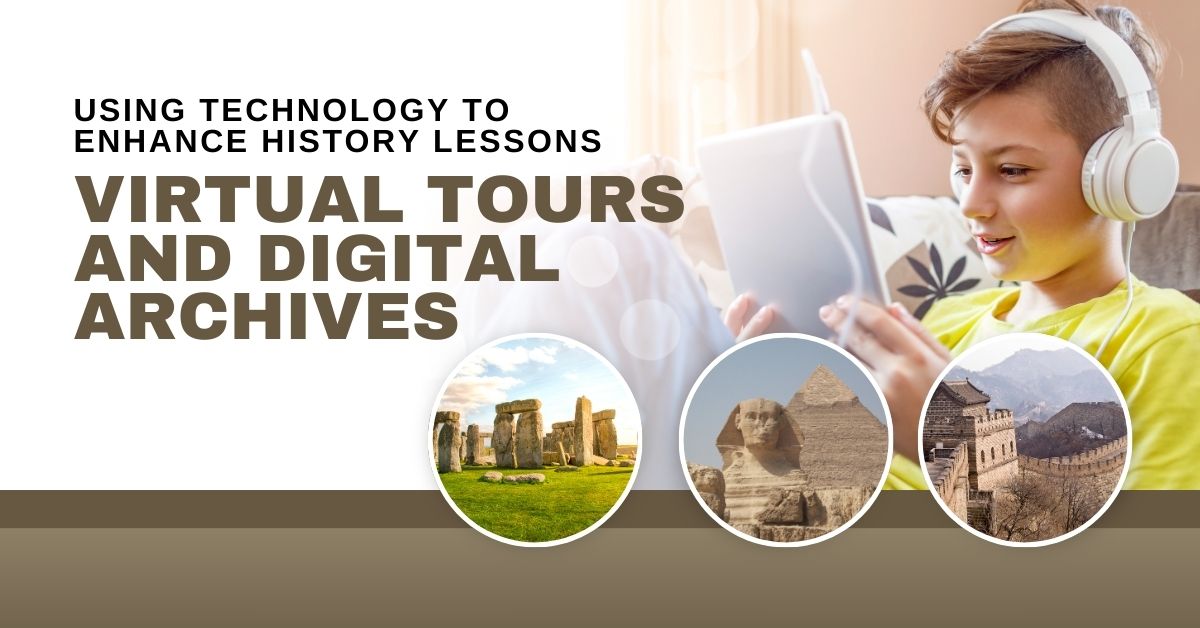Homeschooling offers a unique opportunity for parents to tailor their child’s education. However, teaching history can often seem like a daunting task. How do you make dates and facts engaging? How do you bring ancient civilizations to life? Enter the digital age, where technology transforms static history lessons into dynamic learning experiences.
This blog will explore how virtual tours and digital archives can revolutionize your homeschool history curriculum, making history not only accessible but fascinating.
Bringing History Alive With Technology
History is more than just a list of names and dates; it tells the story of humanity. For homeschooling parents, though, making history lessons engaging can be a significant challenge. Textbooks often fail to spark interest or imagination. This is where technology becomes a valuable tool, offering a fresh and innovative way to teach history.
Technology enables students to experience history in immersive, dynamic ways. Imagine your child stepping into the shoes of a Roman gladiator or exploring the grandeur of ancient Egypt, all without leaving your home. By integrating resources such as virtual tours and digital archives into your homeschool curriculum, students can connect with history on a deeper level. Here’s how these tools can bring history to life:
Virtual Tours
Virtual tours allow students to “visit” historical sites from their computers or tablets. These experiences are visually stimulating and give context to historical events, making them more engaging and memorable. Benefits include:
- World Exploration Without Travel: Students can walk through the ruins of Pompeii, explore the halls of the Louvre, or experience the solemn beauty of Auschwitz via a screen.
- Enhancing Understanding of Historical Significance: For example, exploring the Great Wall of China virtually offers a sense of its massive scale and its importance throughout history.
- Engagement Through Immersion: Seeing a place firsthand—even digitally—is far more compelling than reading about it in a textbook.
Digital Archives
Digital archives provide access to an extensive collection of primary documents. These resources help students interact directly with artifacts of the past, fostering critical thinking and a deeper sense of history. Key advantages include:
- Access to Rare Materials: Letters, photographs, government documents, and newspaper clippings that were once stored in faraway institutions are now just a click away.
- Building Analytical Skills: By studying primary sources, students learn to interpret historical evidence and draw their own conclusions.
- Bringing History to Every Home: Digital archives make these resources accessible to homeschool families regardless of location or background.

Catering to Different Learning Styles
Another remarkable strength of using technology in history lessons is its ability to adapt to different learning styles:
- Visual Learners: Virtual tours provide vibrant, rich imagery that captures their interest.
- Hands-On Learners: Digital archives allow them to actively engage with historical materials, creating an interactive experience.
- Personalized Learning: With multiple ways to interact with content, students can learn in ways that resonate most with them, making the experience more impactful.
Fostering Active Learning
Technology also shifts the focus from passive to active learning. Rather than simply absorbing information, students are encouraged to question, explore, and discover. This approach:
- Sparks curiosity and creates a stronger connection with the subject matter.
- Cultivates critical thinking and problem-solving skills.
- Builds a lifelong love of learning, preparing students for a complex and information-rich world.
A Necessity, Not a Trend
Integrating technology into history lessons isn’t just a modern luxury; it’s a necessity. These tools help transform how students perceive and understand history, making the subject engaging, accessible, and relevant. By stepping into the past through virtual tours and digital archives, students can experience history as a vivid, living story rather than a static set of facts.
For homeschooling parents, leveraging these tools can turn history lessons into meaningful adventures, inspiring a deeper appreciation for the events and people that shaped our world.
Integrating Virtual Tours And Digital Archives Into Homeschooling
Incorporating technology into your homeschool history curriculum may seem overwhelming at first, but with the right tools and strategies, it can be a seamless transition. Start by exploring platforms that offer high-quality virtual tours. Websites like Google Arts & Culture, for instance, provide free access to tours of museums, heritage sites, and cultural treasures worldwide. These tours are often accompanied by rich descriptions and educational materials, making them ideal for homeschooling.
When it comes to digital archives, numerous resources are available online. The Library of Congress, for instance, has an extensive digital collection that includes documents, photographs, maps, and recordings. Similarly, the British Library offers access to a vast array of digitized historical materials. Integrating these resources into your curriculum can provide students with firsthand accounts of historical events, fostering a deeper understanding of the past. The following are a few ideas to integrate technology tools into homeschool history:
Create a Virtual Field Trip Project: Assign your child a project where they create their own virtual field trip. Using platforms like Google Earth or virtual reality apps, they can “visit” various historical landmarks relevant to their current study topic. They can document their journey by creating a digital scrapbook, including screenshots, notes, and reflections on each site they explore. This project not only makes learning more interactive but also helps develop research and presentation skills.
Leverage Online History Simulations: There are several online platforms that offer history-based simulations or games. These tools immerse students in different historical periods, allowing them to make decisions and understand the consequences of historical events. For example, the game “Mission US” lets students experience pivotal moments in American history through the eyes of a young protagonist. Such simulations encourage strategic thinking and empathy by placing students in the shoes of historical figures.
Utilize Storytelling Platforms: Encourage students to create their own historical narratives using storytelling tools like StoryMapJS or Microsoft Sway. These platforms allow students to compile information and create engaging stories with multimedia elements. They can map out events from a specific period and visually present them with accompanying narratives, images, and videos, which makes history come alive through storytelling.
Engage with Historical Podcasts and YouTube Channels: Incorporate auditory and visual content by assigning episodes from reputable history podcasts or YouTube channels. Many creators specialize in captivating retellings of historical events or deep dives into specific topics. After listening or watching, students can participate in discussions, reflect through essays, or even create their own podcast-style recordings to convey their interpretations and thoughts on the content, further enhancing their comprehension and communication skills.
Integrating these technology tools into your homeschool history curriculum not only broadens the educational materials available but also keeps students engaged by presenting history in diverse formats, encouraging a multi-dimensional understanding of the past. To effectively integrate these tools, consider tailoring your lessons to include both virtual tours and digital archives. For example, if you’re studying the French Revolution, take a virtual tour of Versailles Palace and supplement it with primary documents from the period.
Encourage your child to analyze these resources, ask questions, and form interpretations. This approach not only enhances their understanding of history but also develops essential skills such as critical thinking, analysis, and problem-solving.
The Future Of History Education In Homeschooling
The use of technology in homeschooling is not just about keeping up with trends; it’s about preparing students for the future. By embracing digital tools, homeschooling parents can provide their children with a more comprehensive and engaging education. The ability to explore history through virtual tours and digital archives opens up a world of possibilities, making the past accessible and relevant to today’s learners.
Adapting to new educational tools is crucial for ensuring that students remain engaged and motivated. The positive impact of technology on children’s learning experiences cannot be overstated. It allows them to connect with history in a way that is meaningful and enriching, fostering a deeper appreciation for the subject.
As we look to the future, it’s essential for homeschooling parents to continue exploring innovative ways to enhance their history lessons. By staying informed about new technologies and educational resources, they can provide their children with a well-rounded education that prepares them for the challenges and opportunities of the modern world.
Enriching A Student’s Learning Experience
In conclusion, the integration of technology into homeschool history curriculums offers an exciting opportunity to enrich students’ learning experiences. By utilizing virtual tours and digital archives, homeschooling parents can provide their children with an engaging and immersive education that fosters a lifelong love of learning. These tools not only make history more accessible but also encourage critical thinking and active participation in the learning process.
For homeschooling parents looking to enhance their history lessons, the possibilities are endless. By exploring new technologies and resources, they can create a dynamic and interactive curriculum that caters to their child’s unique learning style. The result is a more personalized and meaningful education that prepares students for the future. We invite you to share your experiences with using technology in homeschooling and to explore further resources on this topic.
Together, we can continue to enhance the quality of education for homeschooling families, ensuring that history remains a vibrant and essential part of the curriculum.





